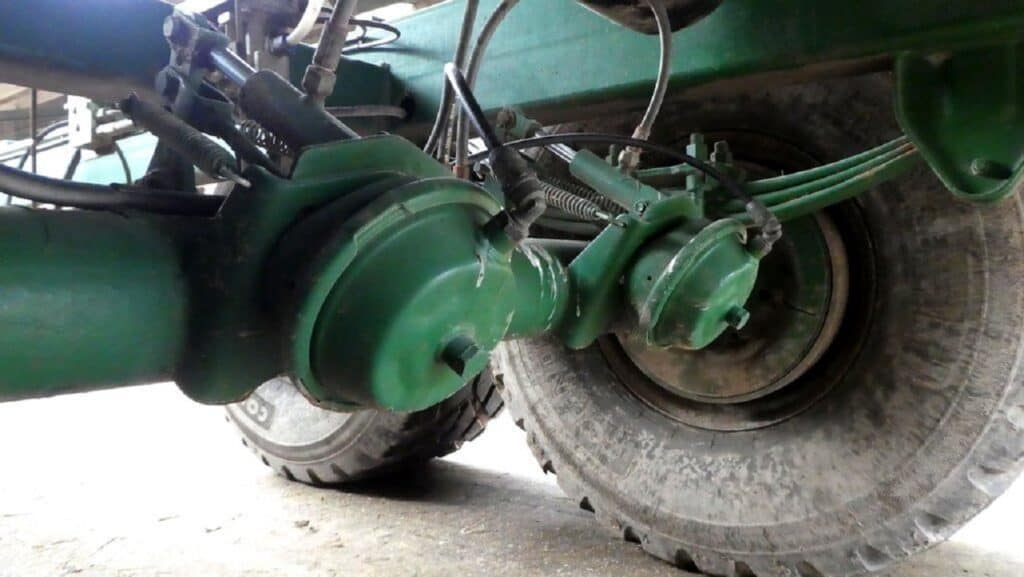
How Do Semi Truck Air Brakes Work
Air brakes are the unsung heroes that keep semi-trucks – and everyone around them – safe on the road.
When you see a massive 80,000-pound truck smoothly come to a stop, it’s thanks to the powerful workings of its air brake system.
Let’s explore how these systems work, what they’re made of, and why they’re the best choice for big rigs.
How Air Brakes Work: Step by Step
- Brake Pedal Pressed: When the driver steps on the brake pedal, compressed air flows from storage tanks (reservoirs) through valves and into the brake chambers.
- Pushrods and Slack Adjusters: The chambers activate pushrods, which in turn push against slack adjusters. These adjusters convert the force into a twisting motion.
- S-Cam in Action: The twisting motion rotates the “S-cam,” which forces the brake shoes outward and pressed against the brake drum.
- Friction Does Its Job: The friction created between the brake shoes and drum slows down the wheel, bringing the truck to a halt.
- Releasing the Brakes: When the driver lets off the brake pedal, the air is released, and springs pull the brake shoes away from the drum, allowing the truck to move again.
| Step | Description |
|---|---|
| 1 | Driver presses the brake pedal, sending compressed air from storage tanks to brake chambers. |
| 2 | Air pressure in brake chambers activates pushrods, which in turn rotate slack adjusters. |
| 3 | Slack adjusters create a twisting force that rotates the S-cam. |
| 4 | Rotating S-cam pushes brake shoes outward, pressing them against the brake drum. |
| 5 | Friction between brake shoes and drum slows the wheel and the truck. |
| 6 | Driver releases brake pedal, air vents out, and springs pull brake shoes away from the drum, allowing the truck to move. |
Key Parts of an Air Brake System
- Air Compressor: The heart of the system, driven by the engine, it generates compressed air.
- Governor: Regulates air pressure, ensuring it doesn’t get too high.
- Air Reservoirs: Where the compressed air is stored.
- Safety Valve: Protects the system from excess pressure, releasing air if needed.
- Brake Pedal: The driver’s way of controlling the brakes.
- Brake Chambers: Convert air pressure into mechanical force.
- Pushrods, Slack Adjusters, S-Cam, Brake Shoes, Brake Drum Work together to create the friction that actually slows the truck.
- Return Springs: Pull the brakes off the drum when air is released.
- Air Dryer: Removes moisture to prevent system damage.
| Component | Function |
|---|---|
| Air Compressor | Generates compressed air, powering the system. |
| Governor | Regulates air pressure for safety. |
| Air Reservoirs | Store compressed air. |
| Safety Valve | Protects from system overpressure. |
| Brake Pedal | Driver’s control to initiate braking. |
| Brake Chambers | Convert air pressure into mechanical force. |
| Pushrods, Slack Adjusters, S-cam | Transfer and transform force to apply the brakes. |
| Brake Shoes & Drum | Create the friction that stops the truck. |
| Return Springs | Release the brakes when air pressure is removed. |
| Air Dryer | Removes moisture to prevent system damage. |
Why Air Brakes Rule for Big Rigs
- Reliability: Air is everywhere, so they can’t “run out” like hydraulic brakes can.
- Power: Can control the immense weight of semi-trucks.
- Versatility: Compressed air is also used for things like horns and seat adjustments.
The Downside
- Cost & Complexity: More expensive and complex to maintain than hydraulic brakes.
- Special Training: Drivers need specific training and licensing.
| Advantages | Disadvantages |
|---|---|
| Reliable (unlimited air supply) | More expensive and complex to maintain |
| Powerful stopping force | Requires specialized driver training |
| Compressed air is versatile for other truck systems |
Sources
- Federal Motor Carrier Safety Administration (FMCSA): They have detailed regulations and manuals governing commercial vehicle brakes. Search their site for “air brakes” for technical guides and safety information. (https://www.fmcsa.dot.gov/)
- National Highway Traffic Safety Administration (NHTSA): You can find research, testing data, and safety standards regarding air brakes on their website. (https://www.nhtsa.gov/)
- Commercial Vehicle Training Association (CVTA): Offers educational resources and training materials focused on commercial vehicles, including detailed breakdowns of air brake systems. (https://cvta.org/)
- North American Transportation Management Institute (NATMI): Provides advanced technical training, including courses and certifications specifically on air brake systems. (https://www.natmi.org/)
The Bottom Line
Air brakes may be complicated, but they do an essential job with impressive power and reliability.
Next time you see a semi-truck come to a smooth stop, appreciate the engineering marvel that made it possible!
We hope you enjoyed this post on How Do Semi Truck Air Brakes Work let us know in the comments below what you think.

Pingback: A Commercial Truck Driver’s Guide to Emergency Road Side Service